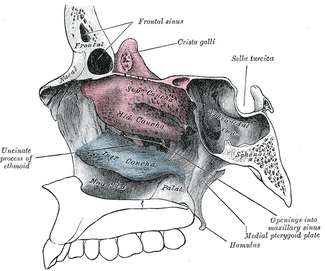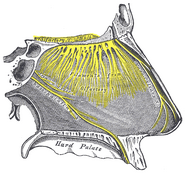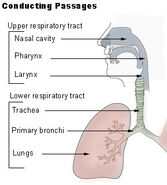Assessment |
Biopsychology |
Comparative |
Cognitive |
Developmental |
Language |
Individual differences |
Personality |
Philosophy |
Social |
Methods |
Statistics |
Clinical |
Educational |
Industrial |
Professional items |
World psychology |
Biological: Behavioural genetics · Evolutionary psychology · Neuroanatomy · Neurochemistry · Neuroendocrinology · Neuroscience · Psychoneuroimmunology · Physiological Psychology · Psychopharmacology (Index, Outline)
| Nasal cavity | ||
|---|---|---|
| Anatomy of the nasal cavity | ||
| Latin | cavum nasi | |
| Gray's | subject #223 994 | |
| System | ||
| MeSH | A04.531.449 | |
| Lateral wall of nasal cavity. | ||
The nasal cavity (or nasal fossa) is a large air-filled space above and behind the nose in the middle of the face.
Function[]
The nasal cavity is important in warming and cleaning the air as it is inhaled. The nasal cavity also contains organs involved in olfaction - sensory smelling.
Borders[]
The nasal cavity is enclosed by the nasal bone above and by the maxilla and ethmoid bone on the sides. The palate separates the nasal cavity from the mouth. To the front of the nasal cavity is the nose, while the back is continuous with the pharynx. The paranasal sinuses are connected to the nasal cavity through small orifices called ostia.
The nasal cavity is divided in two by a vertical fin called the nasal septum. On the sides of the nasal cavity are three horizontal outgrowths called turbinates or conchae (singular "concha"). These turbinates disrupt the airflow, directing air toward the olfactory epithelium on the surface of the turbinates and the septum. The vomeronasal organ is located at the back of the septum and has a role in pheremone detection.
Cilia and mucus along the inside wall of the nasal cavity trap and remove dust and germs from the air as it flows through the nasal cavity. The cillia move the mucus down the nasal cavity to the pharnyx, where it can be swallowed.
Blood and nerve supply[]
There is a rich blood supply to the nasal cavity. In some animals, such as dogs, the capillary beds flowing through the nasal cavity help cool the blood flow to the brain.
Blood supply comes from branches of both the internal and external carotid artery, including branches of the facial artery and maxillary artery. The named arteries of the nose are:
- Sphenopalatine artery, a branch of the maxillary artery.
- Anterior ethmoidal artery, a branch of the opthalmic artery
- Branches of facial artery supplying the vestibule of the nasal cavity.
Innervation[]
Innervation of the nasal cavity responsible for the sense of smell is via the olfactory nerve, which sends microscopic fibers from the olfactory bulb through the cribiform plate to reach the top of the nasal cavity.
General sensory innervation is by branches of the trigeminal nerve (V1 & V2):
- Nasociliary nerve (V1)
- Nasopalatine nerve (V2)
- Posterior nasal branches of Maxillary nerve (V2)
The entire nasal cavity is innervated by autonomic fibers. Sympathetic innervation to the blood vessels of the mucosa causes them to constrict, while parasympathetic innervation of the mucosa controls secrection by mucous glands.
Diseases[]
Diseases of the nasal cavity include viral infections and nasal cavity cancer.
Empty nose syndrome.
Additional images[]
See also[]
- Nasal irrigation
External links[]
Look up this page on
Wiktionary:
Nasal cavity
http://www.emptynosesyndrome.org/whatisens.html
Anatomy: respiratory system |
|---|
|
Nose • Nasal cavity • Pharynx • Larynx • Trachea • Lungs • Bronchi • Alveoli • Conducting zone • Respiratory zone |
es:Fosa nasal fr:Cavité nasale lt:Nosies ertmė pt:Fossa nasal simple:Nasal cavity
| This page uses Creative Commons Licensed content from Wikipedia (view authors). |



